Parallel Universes, Multiverse
The universe we live in may not be the only one out there. In fact, our universe could be just one of an infinite number of universes making up a "multiverse." The subject of parallel universes used to belong to the realm of science fictions but now cosmologists propose that our Universe might be just one of many in an ever-multiplying network of parallel universes, which they call the multiverse. Recent observational data open up the possibility that it is conceivable scientifically with some creative imagination. The Table below summarizes our current ideas on the different ways that a multiverse might exist.
| Multiverse | Brief Description | Theoretical Base |
|---|---|---|
| Infinite | There must be repeated version of each universe in very large sample | Infinite size of the cosmos |
| Inflationary | Bubble universes are created in eternal state of inflation | Theory of inflation |
|
Brane Cyclic Landscape |
Universes exist on 3-D brane Interacting braneworlds produce cycles of cosmic expansion Universes reside in the valleys of the vacuum energy map |
Theory of superstring |
| Quantum | Multiverse is created by realization of all the quantum probabilities | Quantum Theory |
| Mathematical | All possible mathematical equations have correspondence to some real universes | Philosophy |
Table: Five Scenarios of Multiverse
1. Infinite Universes
Scientists can't be sure what the shape of space-time is, but most likely, it's flat (as opposed to spherical or even donut-shape) and stretches out infinitely. But if space-time goes on forever, then it must start repeating at some point, because there are a finite number of ways particles can be arranged in space and time.
So if you look far enough, you would encounter another version of you — in fact, infinite versions of you. Some of these twins will be doing exactly what you're doing right now, while others will have worn a different sweater this morning, and still others will have made vastly different career and life choices.
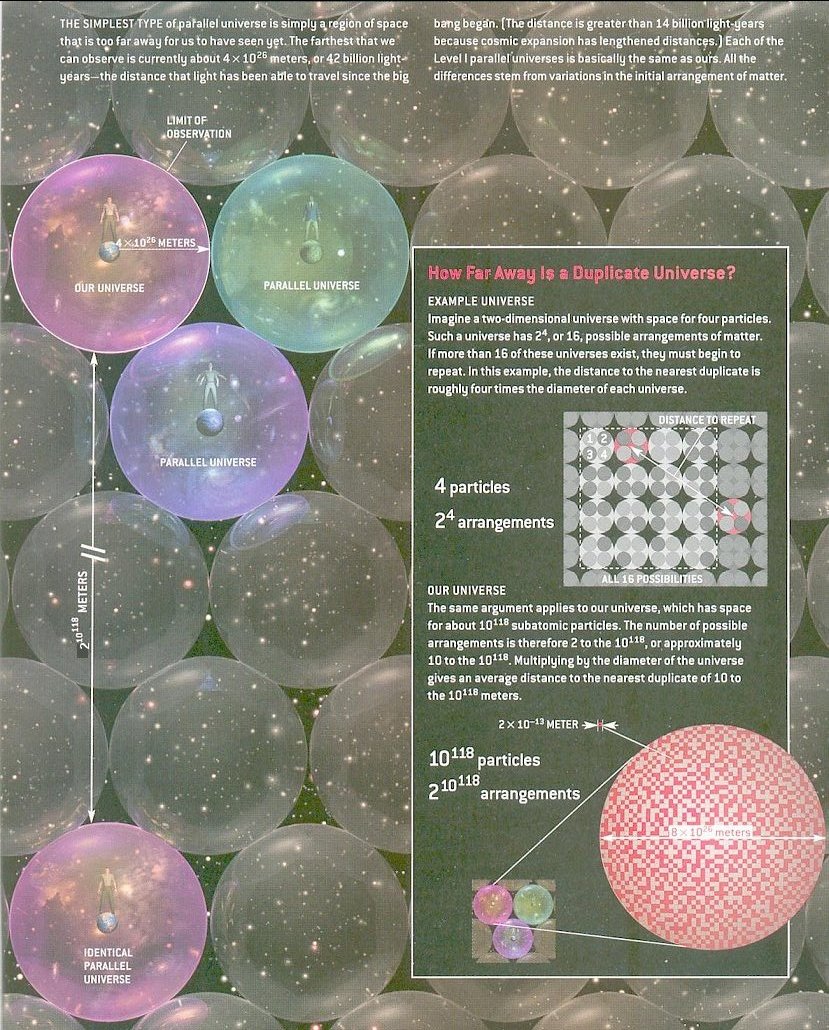
Figure 1: Parallel Universes
Because the observable universe extends only as far as light has had a chance to get in the 13.7 billion years since the Big Bang (that would be 13.7 billion light-years), the space-time beyond that distance can be considered to be its own separate universe. In this way, a multitude of universes exists next to each other in a giant patchwork quilt of universes.
Our universe with a size of about 1026 meters (as limited by the event horizon) is just a speck in comparison to this vast expand. The number of ways to arrange matter in the space outside our universe is enormous and each one would have its own event horizon (size); these are the parallel universes. Statistically, an arrangement similar to ours is bound to happen given enough space. Thus there would be universes identical to ours somewhere. However, we cannot communicate with any of these parallel universes because the speed of light is finite.
This conclusion is derived from elementary probability and does not assume speculative modern physics, merely that space is infinite (or at least sufficiently large) in size and almost uniformly filled with matter, as observations indicate. In infinite space, even the most unlikely events must take place somewhere.
2. Bubble Universes
In addition to the multiple universes created by infinitely extending space-time, other universes could arise from a theory called "eternal inflation." Inflation is the notion that the universe expanded rapidly after the Big Bang, in effect inflating like a balloon. Eternal inflation suggests that some pockets of space stop inflating, while other regions continue to inflate, thus giving rise to many isolated "bubble universes."
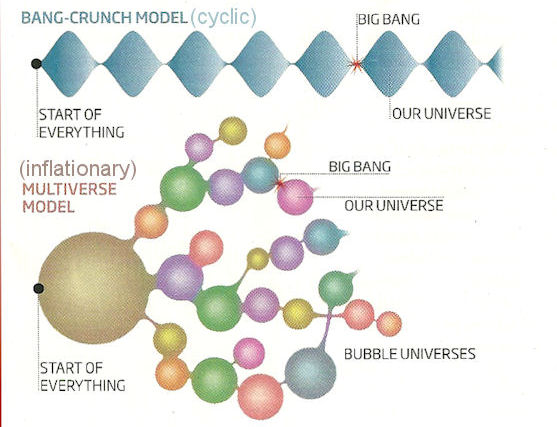
Thus, our own universe, where inflation has ended, allowing stars and galaxies to form, is but a small bubble in a vast sea of space, some of which is still inflating, that contains many other bubbles like ours. And in some of these bubble universes, the laws of physics and fundamental constants might be different than in ours, making some universes strange places indeed.
3 [a,b,c]. Parallel Universes
Another idea that arises from string theory is the notion of "braneworlds" — parallel universes that hover just out of reach of our own. The idea comes from the possibility of many more dimensions to our world than the three of space and one of time that we know. In addition to our own three-dimensional "brane" of space, other three-dimensional branes may float in a higher-dimensional space.
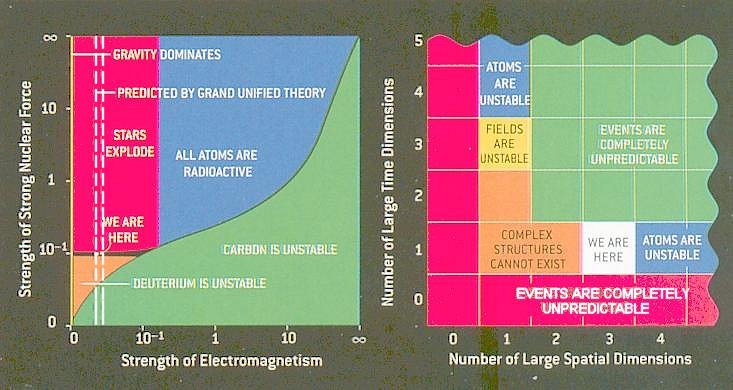
Columbia University physicist Brian Greene describes the idea as the notion that "our universe is one of potentially numerous 'slabs' floating in a higher-dimensional space, much like a slice of bread within a grander cosmic loaf," in his book "The Hidden Reality" (Vintage Books, 2011).
A further wrinkle on this theory suggests these brane universes aren't always parallel and out of reach. Sometimes, they might slam into each other, causing repeated Big Bangs that reset the universes over and over again.
4. Quantum [Daughter] Universes
The theory of quantum mechanics, which reigns over the tiny world of subatomic particles, suggests another way multiple universes might arise. Quantum mechanics describes the world in terms of probabilities, rather than definite outcomes. And the mathematics of this theory might suggest that all possible outcomes of a situation do occur — in their own separate universes. For example, if you reach a crossroads where you can go right or left, the present universe gives rise to two daughter universes: one in which you go right, and one in which you go left.
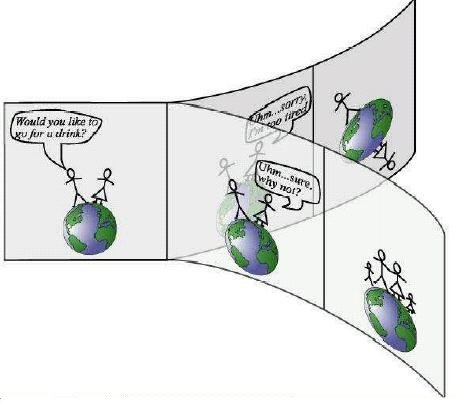
"And in each universe, there's a copy of you witnessing one or the other outcome, thinking — incorrectly — that your reality is the only reality," Greene wrote in "The Hidden Reality."
5. Mathematical Universes
Scientists have debated whether mathematics is simply a useful tool for describing the universe, or whether math itself is the fundamental reality, and our observations of the universe are just imperfect perceptions of its true mathematical nature.
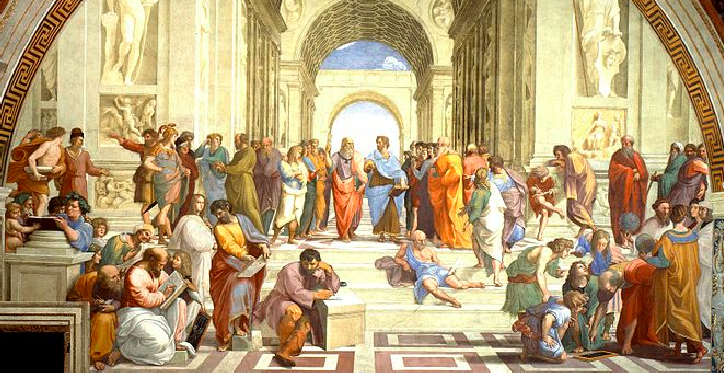
The correspondence between mathematics and physics has been a source of debate that goes as far back as Aristotle and Plato. According to the Aristotelian paradigm, physical reality is fundamental and mathematical language is merely a useful tool. The Platonic argument considers the mathematical structure to be the true reality and observers only perceive it imperfectly. Thus a fundamental asymmetry appears to be built into the very heart of reality - why is only one of the many mathematical structures singled out to describe our universe? It is suggested that complete mathematical symmetry holds: that all mathematical structures exist physically as well. Every mathematical structure corresponds to a parallel universe. As a consequence, each universe is governed by its own fundamental laws of physics. In the figure Aristotle points down to the reality on earth while Plato points up to multiverse.











